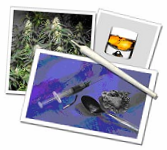

Alcohol Information
Factors affecting the body alcohol concentration
In general, the more alcohol a person consumes the higher will be his or her maximum of breath alcohol concentration. The maximum alcohol level actually attained in the blood or breath will also depend on the following factors:
Nature of alcohol consumed
The concentration of a drink for most rapid absorption into the blood is about 20% alcohol by volume, which corresponds to whisky and water in equal proportions, or to neat sherry.
Because strong solutions of alcohol can irritate the stomach wall and depress the rate of opening of the pyloric valve connecting the stomach to the duodenum, drinks like neat spirits (typically 40% alcohol by volume) have a slower rate of absorption.
Beers, because of their low concentration (typically 3 to 5% alcohol by volume), are also more slowly absorbed because of the large bulk volume of liquid through which most of the alcohol must diffuse in order to reach the walls of the stomach and the duodenum.
The following table to the right shows the typical alcohol concentration in a variety of commonly consumed drinks:
► Drinks taken as aperitifs - such as gin and tonic, or sherry - are probably chosen as they are absorbed quickly, so stimulating the appetite and the flow of digestive juices ready for the meal to follow.
► Carbon dioxide - as in soda water, dry ginger or champagne - marginally hastens the passage of alcohol into the blood, although the exact mechanism by which this occurs is not totally understood.
► In general, the slower the rate of alcohol absorption into the blood, the lower maximum BAC and hence BrAC will be, all other factors being equal.
Time
If the alcohol is consumed over a long period of time, the rate of increase in the BAC due to absorption may be close to the simultaneous breakdown rate in the liver.
This breakdown rate is roughly equivalent to removing the alcohol from at least half a pint of beer (approximately 280ml) or a single measure of spirits (approximately 25ml) every hour. If drinking is maintained at this rate - half a pint of beer or one single spirit per hour - there will be no appreciable increase in the concentration of alcohol in the blood: but any intake above this rate will lead to an increasing BAC.
Thus, the longer the time period over which consumption occurs, the lower will be the final blood or breath alcohol concentration, all other factors being equal.
Stomach contents
The presence of food in the stomach will also influence the maximum alcohol level that will be attained after the consumption of a certain quantity of alcohol. If the stomach and duodenum are empty of solid food then the alcohol comes more quickly into contact with the walls through which absorption takes place. The presence of foods in the stomach and duodenum, particularly fatty substances, impedes absorption of alcohol through these walls and so lessens the maximum blood alcohol level attained.
There is certainly, therefore, a good deal of truth in the old saying that preceding a few drinks with a bottle of milk (which is fatty) or a plate of mashed potato will reduce the effects of the alcohol - although the heavy imbiber should not rely too strongly on this principle!
Body weight
Nearly two-thirds of the human body weight is water. Absorbed alcohol is distributed by the blood and mixes evenly through this water. The larger the body the more water it contains and so the lower the final concentration of alcohol in the blood.
People with much body fat will contain less water than a muscular person of the same body weight. Since alcohol is far less soluble in fat than it is in water, its concentration will reach a higher level in the blood of a fatty person than of the muscular person who has consumed the same quantity of alcohol, all other factors being equal.
Finally, women also have a lower proportional body water content than men, so arrive at a higher blood alcohol concentration for the same quantity of alcohol, at the same body weight.
Above: Extract from Lion Laboratories web site
Factors affecting the body alcohol concentration
In general, the more alcohol a person consumes the higher will be his or her maximum of breath alcohol concentration. The maximum alcohol level actually attained in the blood or breath will also depend on the following factors:
Nature of alcohol consumed
The concentration of a drink for most rapid absorption into the blood is about 20% alcohol by volume, which corresponds to whisky and water in equal proportions, or to neat sherry.
Because strong solutions of alcohol can irritate the stomach wall and depress the rate of opening of the pyloric valve connecting the stomach to the duodenum, drinks like neat spirits (typically 40% alcohol by volume) have a slower rate of absorption.
Beers, because of their low concentration (typically 3 to 5% alcohol by volume), are also more slowly absorbed because of the large bulk volume of liquid through which most of the alcohol must diffuse in order to reach the walls of the stomach and the duodenum.
The following table to the right shows the typical alcohol concentration in a variety of commonly consumed drinks:
► Drinks taken as aperitifs - such as gin and tonic, or sherry - are probably chosen as they are absorbed quickly, so stimulating the appetite and the flow of digestive juices ready for the meal to follow.
► Carbon dioxide - as in soda water, dry ginger or champagne - marginally hastens the passage of alcohol into the blood, although the exact mechanism by which this occurs is not totally understood.
► In general, the slower the rate of alcohol absorption into the blood, the lower maximum BAC and hence BrAC will be, all other factors being equal.
Time
If the alcohol is consumed over a long period of time, the rate of increase in the BAC due to absorption may be close to the simultaneous breakdown rate in the liver.
This breakdown rate is roughly equivalent to removing the alcohol from at least half a pint of beer (approximately 280ml) or a single measure of spirits (approximately 25ml) every hour. If drinking is maintained at this rate - half a pint of beer or one single spirit per hour - there will be no appreciable increase in the concentration of alcohol in the blood: but any intake above this rate will lead to an increasing BAC.
Thus, the longer the time period over which consumption occurs, the lower will be the final blood or breath alcohol concentration, all other factors being equal.
Stomach contents
The presence of food in the stomach will also influence the maximum alcohol level that will be attained after the consumption of a certain quantity of alcohol. If the stomach and duodenum are empty of solid food then the alcohol comes more quickly into contact with the walls through which absorption takes place. The presence of foods in the stomach and duodenum, particularly fatty substances, impedes absorption of alcohol through these walls and so lessens the maximum blood alcohol level attained.
There is certainly, therefore, a good deal of truth in the old saying that preceding a few drinks with a bottle of milk (which is fatty) or a plate of mashed potato will reduce the effects of the alcohol - although the heavy imbiber should not rely too strongly on this principle!
Body weight
Nearly two-thirds of the human body weight is water. Absorbed alcohol is distributed by the blood and mixes evenly through this water. The larger the body the more water it contains and so the lower the final concentration of alcohol in the blood.
People with much body fat will contain less water than a muscular person of the same body weight. Since alcohol is far less soluble in fat than it is in water, its concentration will reach a higher level in the blood of a fatty person than of the muscular person who has consumed the same quantity of alcohol, all other factors being equal.
Finally, women also have a lower proportional body water content than men, so arrive at a higher blood alcohol concentration for the same quantity of alcohol, at the same body weight.
Above: Extract from Lion Laboratories web site
Industry Testing and Education Management Solutions
